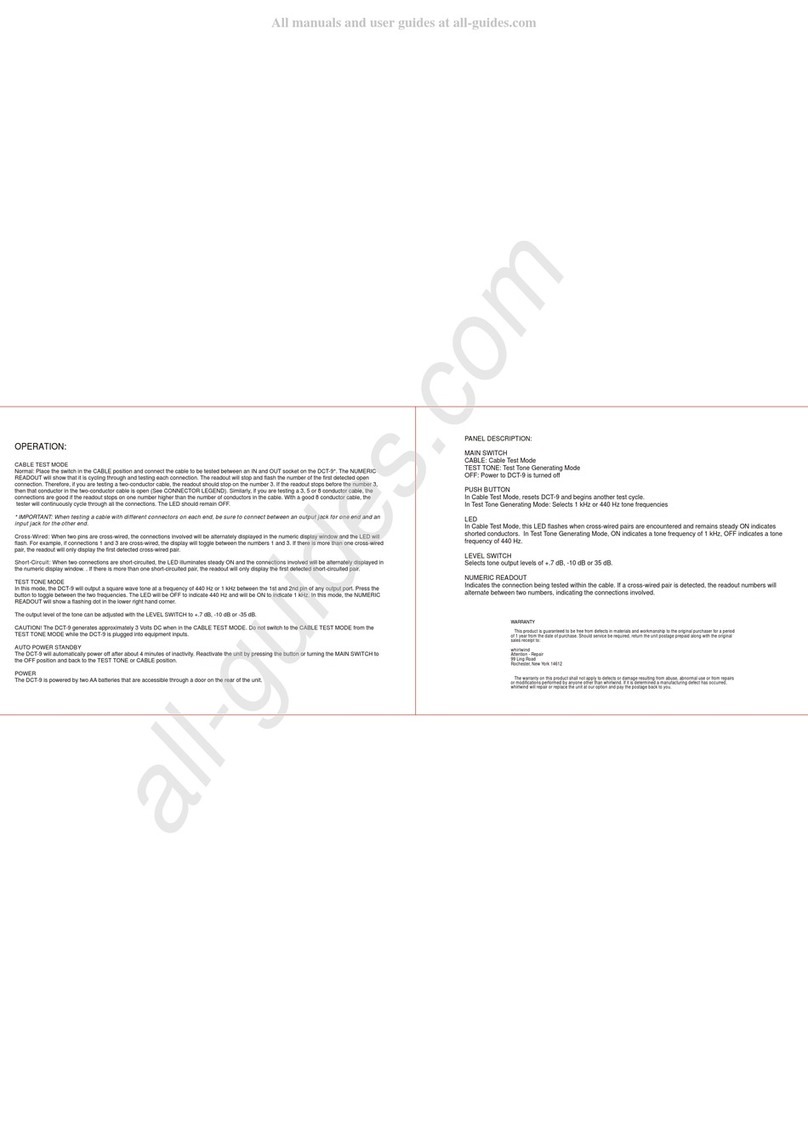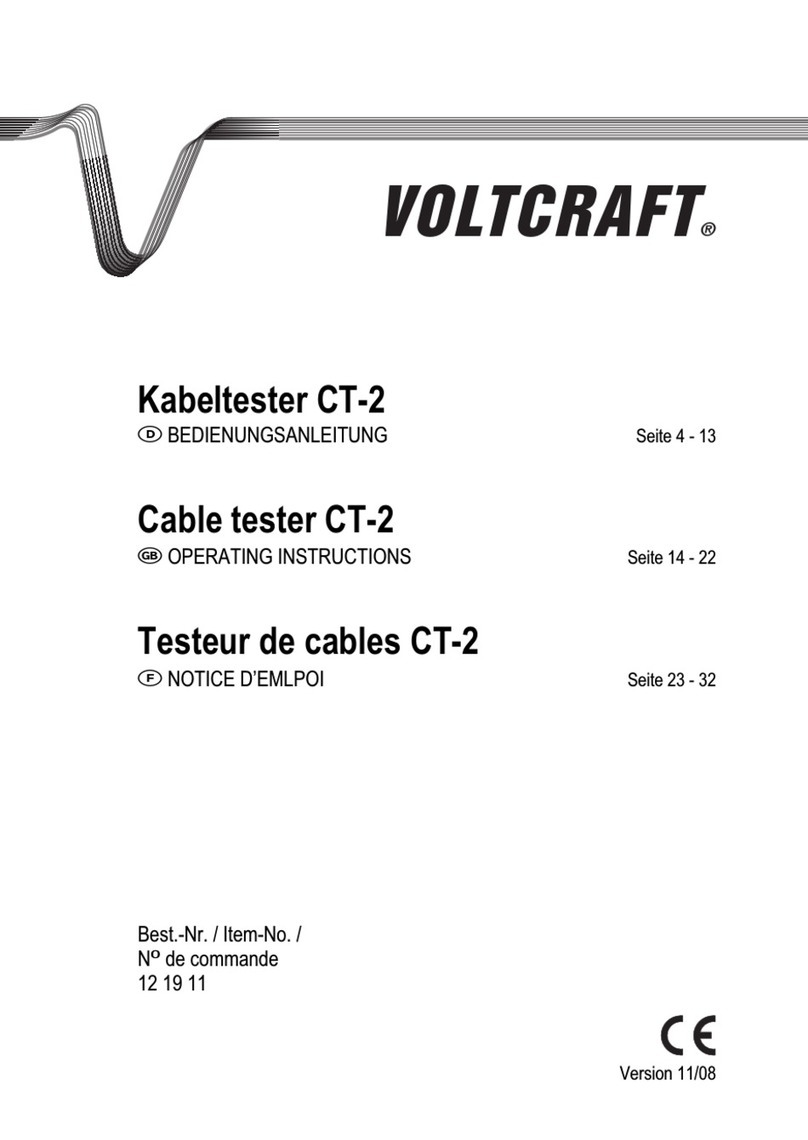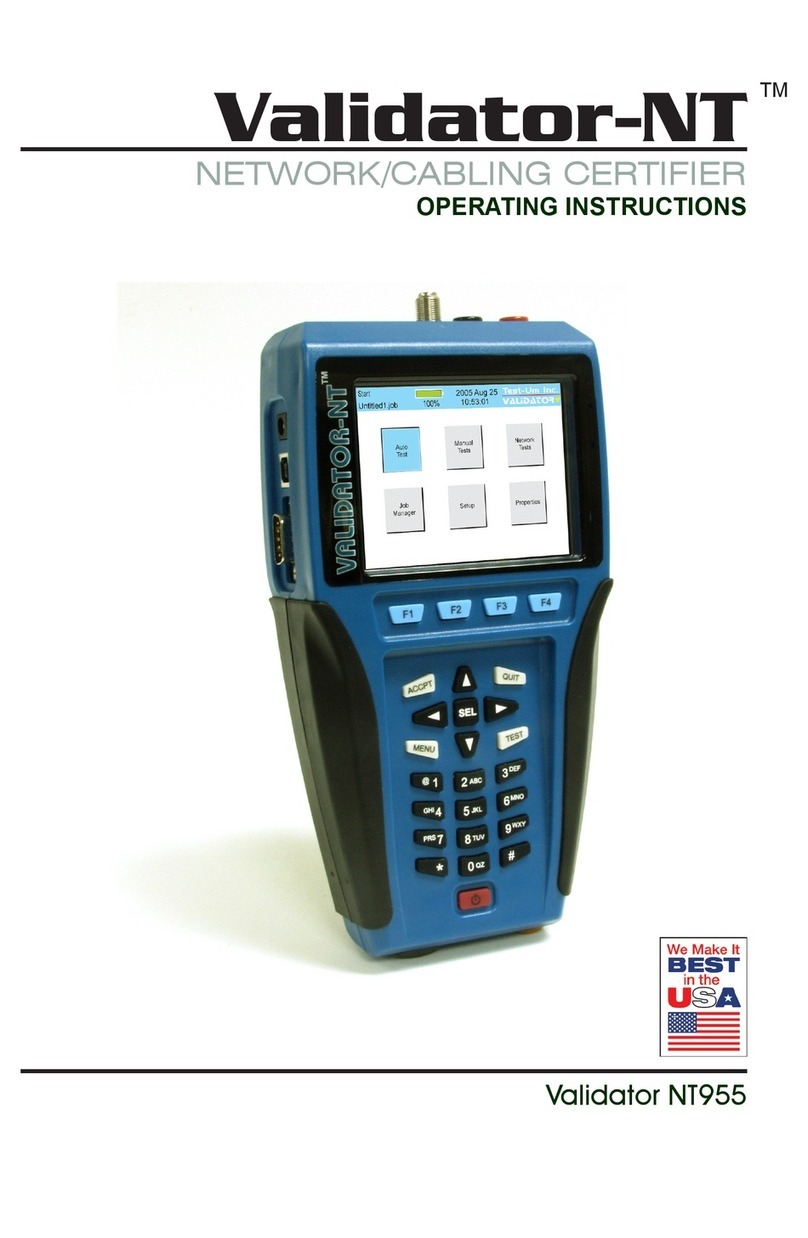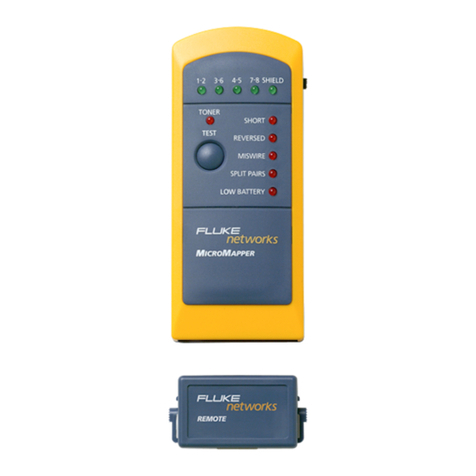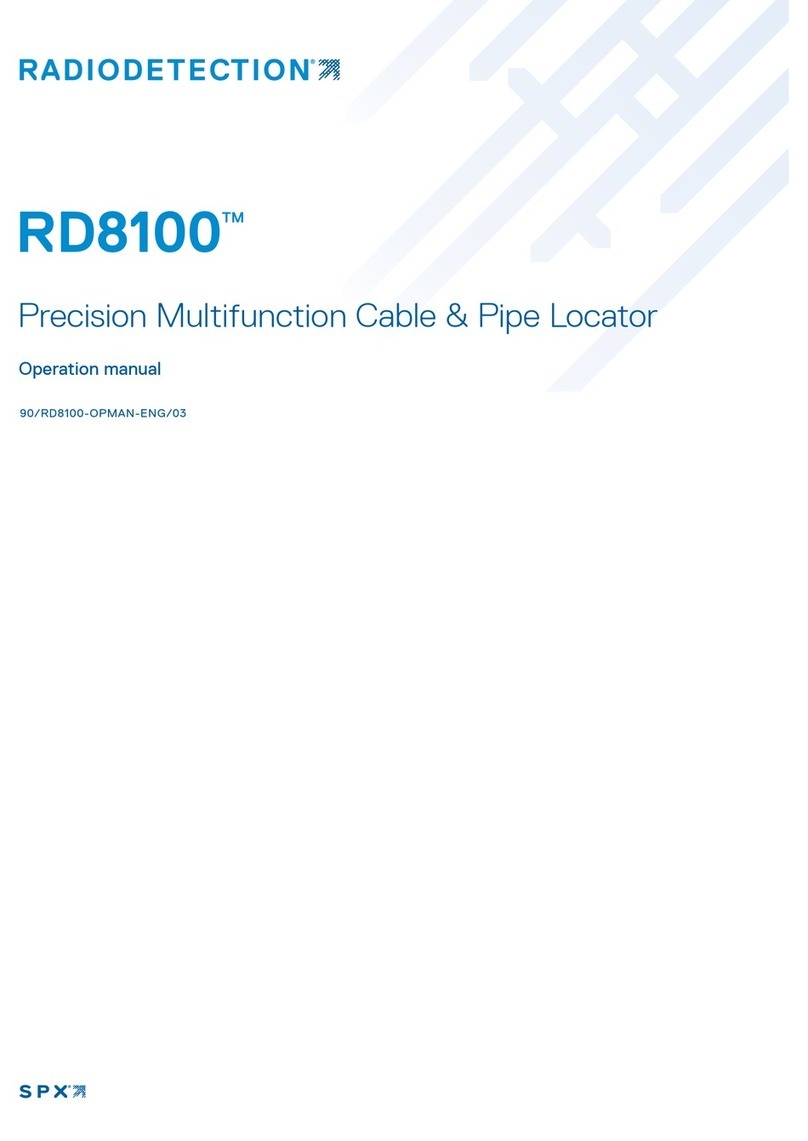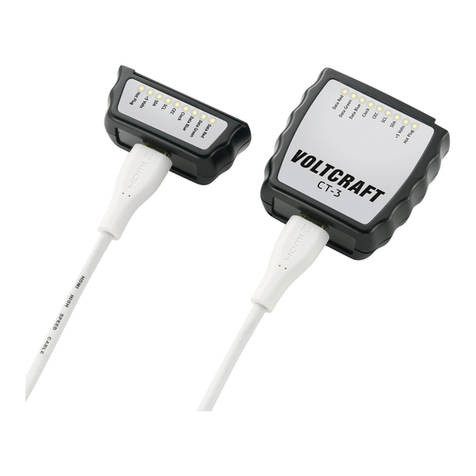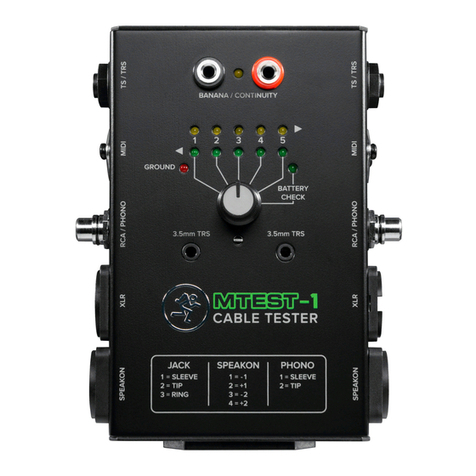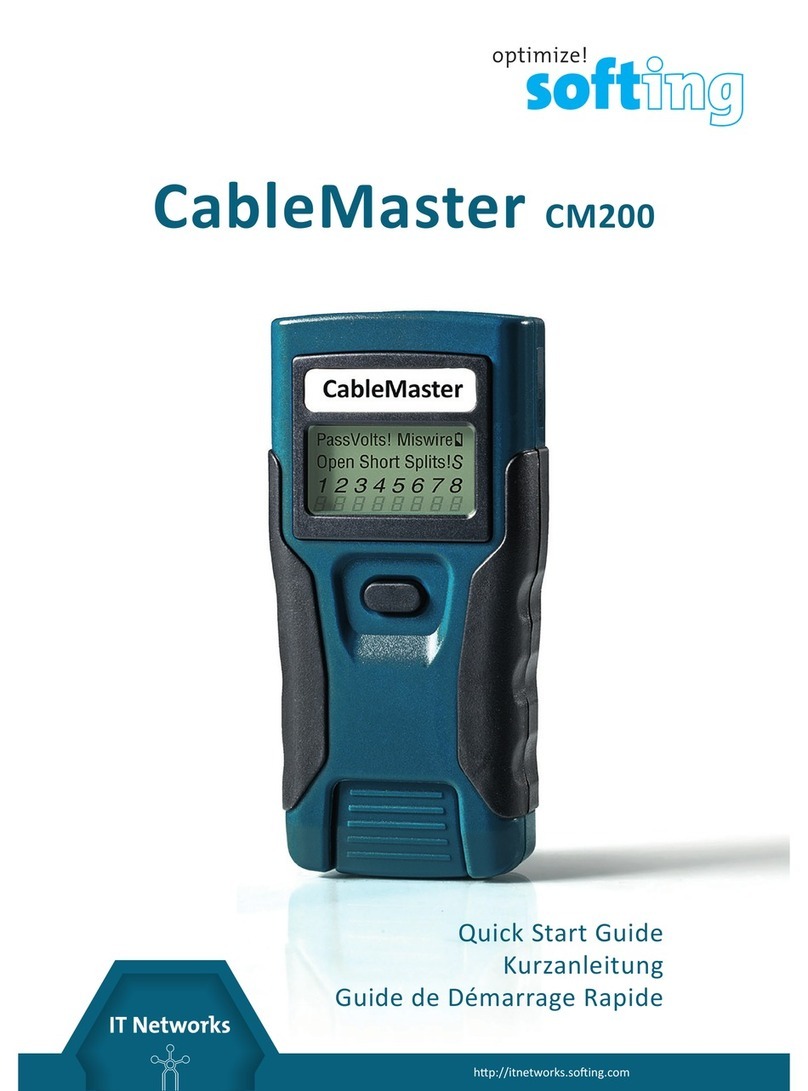Transmedia Germany CNT 10 L User manual

Network Cable Tester
Manual
CNT 10 L
CNT10L_Manual_en.indd 1 25.06.2019 14:19:12

2
CONTENTS
1: INTRODUCTION
1. Introduction
2. Safety Rules and Warnings
3. Product Features
4. Specications
5. Front Panel
6. Operation
7. Cable Repairs
8. Maintenance
9. Accessories
The 4 in 1 Cable Tester tests 4 common LAN
and Computer cables. It tests installed cables
or patch cords with RJ-45, RJ-11, USB, and
BNC connectors. It is intended to test
cables with straight through connections not
cables with reversed or transposed connec-
tions like some LAN crossover cables or
reverse wired telephone cables.
CNT10L_Manual_en.indd 2 25.06.2019 14:19:12

3
2: SAFETY RULES &
WARNINGS
2.1 Read all instructions in this manual before using
this tester. Failure to do so may result in damage to the
tester or injury to the user.
2.2 Do not use this tester with it`s case open, or with
parts removed. Doing so may damage the tester and /
or injure the user.
2.3 When using this tester in schools and workshops,
responsible teachers or skilled personnel must control
the usage of this tester. Failure to observe this precau-
tion may result in damage to the tester or injury to the
user.
2.4 Follow the recommendations of any Trade Organiz-
ations or Regulatory Agencies whose scope encom-
passes the use of this tester. Failure to do so may
result in damage to the tester or injury to the user.
2.5 Do not open this tester for maintenance without
rst disconnecting it from all external circuitry. Failure
to observe this precaution may result in damage to the
tester or injury to the user.
2.6 Repairs and maintenance must only be carried out
by qualied service personnel or qualied electricians /
technicians who know the dangers of, and the safety
rules applicable to this type of equipment. Failure to
observe this precaution may result in damage to the
tester or injury to the user.
2.7 Do not touch the ends of the cables when making
tests. An unexpected dangerous potential may be
present. Failure to observe this precaution may result
in damage to the tester or injury to the user.
2.8 Do not apply voltage or current to any of the tes-
ter‘s connectors. Doing so may damage the tester and
/ or injury the user.
WARNING
This tester is not intended for use on
powered circuits. Attaching this tester to
a powered circuit can result in damage to
the tester or injury to the user.
CNT10L_Manual_en.indd 3 25.06.2019 14:19:12

4
2.9 This tester is not for use by children. Failure to
observe this precaution may result in damage to the
tester or injury to the user.
2.10 Do not use this tester to make measurements
in adverse environments such as rain, snow, fog, or
locations with steam, explosive gases or dusts.
2.11 Do not use tester in condensing atmospheres.
That is, do not use tester in conditions where ambient
temperature and humidity could cause condensation of
water inside of the tester.
2.12 Do not use this tester if it is wet, either from
exposure to the weather, or after cleaning the case of
the tester.
2.13 Do not attempt immediate use of the tester when
bringing it from a cold environment to a warm environ-
ment. Condensation of water, inside and outside of the
tester, may produce dangerous measuring conditions.
Allow the tester to warm to room temperature before
using.
2.14 Do not modify this tester. Changing the design
may make the tester unsafe and may result in injury to
the user.
2.15 Do not use this tester if it has undergone long-
term storage under unfavorable conditions.
2.16 Do not use the tester if it has been damaged in
transport.
2.17 Avoid usage near strong magnetic elds (ma-
gnets, loudspeakers, transformers, motors, coils,
Relays, contactors, electromagnets, etc.). The tester
may display readings that are in error.
2.18 Avoid usage near strong electrostatic elds (high
valtage power lines, televisions, computer monitors,
etc.) The tester may display readings that are in error.
2.19 Avoid usage near strong RF elds (radio or televi-
sion transmitters, walkie talkies, cellular phones etc.).
The tester may display readings that are in error.
2.20 Remove the battery when the tester may be left
unused for Ionger than 1 month. Chemical leakage
from the battery could damage the tester.
2.21 Do not use the tester if there is evidence of che-
mical leakage from the battery.
CNT10L_Manual_en.indd 4 25.06.2019 14:19:12

5
3: PRODUCT FEATURES
4: SPECIFICATIONS
3.1 Test 4 types of cables
3.2 Simple one button test
3.3 Ergonomic portable handheld design
3.4 Tests installed wiring or patch cables
3.5 Remote unit stores in Main unit
3.6 600 ft test distance
(RJ-45/RJ- 11 /BNC)
3.7 Convenient battery access
3.8 Built in battery test
3.9 LEDs indicate connections and faults
3.10 Beeper provides audible annunciation
of test results
3.11 Tests shielded (STP) or unshielded
(UTP) LAN cables
3.12 Test shields in USB cables
4.1 Cables Tested:
UTP and STP LAN cables Terminated in RJ-45 male
connectors. (ElA/TIA 568)
RJ - 11 cables with male connectors, 2 to 6 conductors
installed.
USB cables with Type A at plug on one end and type
B square Plug on other end.
BNC cables with male connectors.
4.2 Faults lndicated: No Connection, Shorts, Opens,
crosses.
4.3 Low Battery lndicator: LED lights to indicate low
battery
4.4 Case Dimensions: 6,3x3,3x1.0 inches (LxWxH)
4.5 Weight: 175 grams (Without battery)
4.6 Battery: 1 standard 9-volt alkaline battery.
CNT10L_Manual_en.indd 5 25.06.2019 14:19:12

CONTENTS
6
5.1 Test Button
5.2 Main Display
5.3 RJ-45 Jack
5.4 RJ-11 Jack
5.6 USB Jack
5.7 BNC Jack
CNT10L_Manual_en.indd 6 25.06.2019 14:19:13

7
6: OPERATION
6.1 General Information:
The CNT 10 L Tester performs it`s tests when the
single button on it`s front panel is pressed and
released. 6 Status LEDs indicate the condition of the
cable being tested, as well as informing the user that
Power is turned on, and that the battery is good (or
bad). 8 additional connection LEDs light to indicate
that specic wires in a cable are connected.
Note: Only one cable can be tested at a time. i.e.
A BNC cable and an RJ-45 cable cannot be tested
simultaneously.
6.2 The MAIN and REMOTE unit:
The CNT 10 L Tester consists of a Main unit and a
Remote unit. The Remote unit stores conveniently
on the bottom of the Main unit. lt can be removed or
replaced by sliding it from left to right or right to left
respectively. Use care when removing or replacing
the Remote. Some of the plastic edges are a little
sharp.
The Remote is often attached to the Main unit when
storing, when transporting, or when patch cables are
being tested. The Remote is removed from the Main
unit when an installed (in wall, ceiling, etc.) cable is
being tested.
6.3 Testing Patch cables:
„Patch“ cables have both ends accessible at the
same location. Usually, but not always, these cables
are less than 25ft in length, and are not installed in a
wall or ceiling. Since both ends are accessible, one
end can be plugged into the 5 in 1 Main unit, and
one end into the Remote unit. It is not necessary to
remove the Remote unit from its docked position on
the Main unit.
6.4 Testing lnstalled cables:
To test cables installed in ceilings or walls, or in
applications that prevent the ends from being in the
same location, the Remote can be detached from
the Main unit. Once detached, the Remote can
be attached to one end a cable, and the Main unit
attached to the other end of the cable. These ends
are often in different rooms and on different oors of
a building.
CNT10L_Manual_en.indd 7 25.06.2019 14:19:13

8
6.5 Performing the Test:
Once the Remote and Main unit are attached to the
ends of the subject cable, as described in 6.3 and 6.4,
testing may begin, simply press and release the Test
Button on the Main unit, observe the LED indicators,
and note the beeping sound that comes from the Main
unit.
6.6 lnterpreting the Results:
6.6.1 Power LED:
The Power LED should light whenever the Test Button
is pressed and released. It will stay in for a minimum
of 5 seconds, or for however long the Test Button is
pressed. If the power LED does not light, replace the
battery.
6.6.2 Low Battery LED:
The low Battery LED should not light. If it does, replace
the battery.
6.6.3 No connection LED/Single Beep
If the Remote is not connected to the Main unit with a
cable, or the cable has no intact conductors, the No
Connection LED with light and the Beeper will sound
once.
6.6.4 Connected LED/Lo-Hi Beep/Numbered LEDs
If the Connected LED lights and the Beeper emits a
LoHi beep, examine the numbered LEDs (i .e. LEDs
numbered 1 to 8, and the S LED)
The numbered LEDs corresponding to the type of cable
being tested must light.
Note:
When testing an RJ-45 UTP cable, the S LED must not
light. When testing an RJ-45 UTP cable, the S must
light.
The CNT 10 L is intended to test complete cables.
lt may not nd faults in cables that are intentionally
incomplete. For example, the Standard EIA/TIA 568
RJ-45 terminated Ethernet cable is expected to contain
8 conductors. If only 4 conductors are used between
the RJ-45 connectors, tester may not properly identify
the faults.
RJ-11 cables may have 2 connections, 4 connections,
or as many as 6 connections. For 2 connection cables,
LED 3 and 4 must light .For 4 connection cables, LED
2. 3, 4, and 5 must light. For 6 connection cables. LED
1. 2. 3, 4, 5, and 6 must light.
CNT10L_Manual_en.indd 8 25.06.2019 14:19:13

9
The Numbered LEDs DO NOT indicate that a GOOD
connection exists, only that a connection exists. If the
Short or Cross LEDs are t, there is a fault in the cable.
6.6.5 Connected LED/3Beepers/Short LED/Numbered
LEDs
lf the Connected LED lights, the Beeper emits 3 beeps,
and the Short LED lights, the cable has a fault. The
Numbered LEDs indicate the location of a short.
Note:
In the Short mode, the Numbered LEDs only indicate
the location of the shorts. The other Connections in the
cable are not indicated. If more than 3 numbered LEDs
light, there may be multiple shorts in the cable.
6.6.6 Connected LED/2Beepers/Cross LED/Numbe-
red LEDs
lf the Connected LED lights, the Beeper emits 2 beeps,
and the Cross LED lights, the cable has a fault.
Notes:
In the Cross-mode, the Numbered LEDs indicate
connections but do not indicate the location of the cross.
RJ-11 cables used for telephone Connections are often
crossed. Even new cables are often crossed. This
seldom affects the performance of Standard analog
telephone lines (POTS). Digital telephone lines and old
touch-tone phones may be polarity sensitive. so a cros-
sed cable may prevent them from working properly.
7.1 General Information: The following section provides
information to the user about common cable types,
common failures, and repairs. lt is not meant to be an
exhaustive study of the topic, just some basic informati-
on that the uninitiated may nd helpful.
7.2 Cable damage: When a cable tests badly, either
the wire or the connectors or both may be at fault. lf the
cable has been installed and working, then it‘s likely that
the wire or connectors have been abused in some way.
The wire portion of the cable can be damaged by being
crushed (under the left of a desk), stretched (pulled shar-
ply around a corner), punctured (by a nail or staple), over
loaded (hit by lighting), etc. Similar abuses will damage
the connectors on the ends of the cable. The connectors
can also be damged by excessive insertion and removal
or exing of the cable close to connector body.
7: CABLE REPAIR
CNT10L_Manual_en.indd 9 25.06.2019 14:19:13

10
While the CNT 10 L can identify a bad cable, it cannot
determine if the wire or the connectors are at fault. The
user must examine the different parts of the cable to
determine the cause of failure and take the appropriate
steps to correct the problem.
7.3 Which end is bad? The CNT 10 L like many cable
testers, cannot nd the location of the faul, or even
determine which end or connector is bad. lt simply
knows that a fault exists. The user must locate the fault
and take the appropriate action.
7.4 Cables with Molded on ends: Many cables have
molded on ends that cannot be opened up for repair.
The entire cable must be replaced, or the molded on
end removed and replaced with a user serviceable
connector. These types of cables usually fail from
Opens or Shorts. They seldom fail from a Crossed
connection.
7.5 Cables with Crimped on RJ connectors: Crim-
ped on RJ connectors cannot be reused or repaired.
New connectors must be installed on the cable. If the
cable being tested has just been made up or put in ser-
vice, and it tests as Open or Crossed, the RJ connec-
tors have probably been installed incorrectly. Shorts
very seldom occur as the result of a badly crimped RJ
connector, so the user should suspect a problern with
the wire (possibly a staple or mail through the wire, or
a crushed or pinched wire) if the CNT 10 L indicates a
short. A visual examination of the RJ connectors may
reveal the fault··· but keep in mind that whatever the
cause of a connector problem (i.e. miswiring, improper
stripping of the wire, bad crimp, etc.) The only solution
is to replace the connector. Consequently, it is not
necessary for the user to know the exact cause of the
problem, simply to make sure that he installs the new
connector correctly!
7.6 Conicting Results: Sometimes, the tests results
of the tester seem to conict with the performance of
the cable ··· i.e., the cable tests badly but works OK,
or vice versa. The following items Iist some of the
reasons why.
7.6.1 The tester lndicates the cable is not working,
but my LAN works OK: Installed LAN cables with
RJ- 45 connectors that bave been in service and
working OK may lest as Open, Shorted, or Crossed.
Here‘s why·· ·
CNT10L_Manual_en.indd 10 25.06.2019 14:19:13

11
The EIA/TIA 568 standard for LAN cables only uses 4
of the wires in the eight-wire cable. The other 4 wires
in the cable may have faults, but these will not affect
the operation of the LAN. The CNT 10 L tests all of the
wires in the LAN cable, and identies the faults. Even
though these wires may not being used in the LAN
system.
Not all LAN cables are wired straight through Crossover
cables used on LANs are purposely miswired, with their
Receive and Transmit wires cross over. The CNT 10 L
will test this as a bad cable, but it may work just ne as
Crossover cable.
7.6.2 The CNT 10 L says my cable is good, but it
does not work on my LAN: Many cable testers like
the CNT 10 L only perform continuity style tests (open,
short. crossed, etc). Ethernet LAN cables are const-
ructed in a special way. The 8 wires inside are grouped
into 4 pairs of 2 wires each. Not only must the 8 wires
connect form end to end of the cable, the pairs in the
cable must connect to specic pins of RJ-45 plugs on
to the ends of cable, ignoring the pairing(as described
in ElA/TIA 568), and the cable will test ok. But when
the cable is tried on the LAN, it does not work. This is
because the Iack of the proper pairing causes exces-
sive cross talk in the cable. Preventing the LAN from
working. This type of cable fault is sometimes call a split
pair or double split pair, to detect this type of fault, a
more sophisticated tester capable of performing a NEXT
test (Near End Cross Talk) must be used.
Notes:
Cross talk increases with the length of the cable. A LAN
system will tolerate a certain amount of cross talk. A
short cable (10ft or less) that is improperly paired may
work just ne. However, Ionger cables, paired in exactly
the same way, may not work. This explains why an
installer can make short Jumper cables that work (al-
though they are improperly paired), but when he installs
RJ-45‘s in exactly the same way on a Ionger cable, the
cable does not work.
7.6.3 The CNT 10 L says my phone cable is bad, but
my
phone works OK.
Most single line telephones only use 2 wires in a
modular cable. The modular cable, which terminates in
RJ-11connectors, could have as may as 6 wires in it.
The unused wires may have faults, which the
CNT 10 L identies, but these faults may have no effect
an the working 2-wire telephone circuit.
CNT10L_Manual_en.indd 11 25.06.2019 14:19:13

12
Many telephone cables with RJ-11 plugs / jacks
are wired in reverse. The CNT 10 L will show
that a cable like this is crossed. A cable like this
reverses the polarity of the telephone line. Most
regular telephones made in the last 20 years are
not polarity sensitive. So, even though the cable
is wired in reverse (crossed), it may work OK.
Early touch-tone telephones and answering
machines were polarity sensitive. lf connected in
reverse polarity, the touch-tone phone may not
dial out (no touch), and the answering machine
may not answering machine may not answer
when the line rings.
7 .6.4 The CNT 10 L says my RJ-11 phone
cable is good, but my phone doesn‘t work.
First, make sure the telephone line is active.
The “good“ cable may result in a reversed line.
The line is not actually being reversed in the
good cable it‘s been reversed somewhere else
along the wire. Either the reversed cable can be
located and corrected, or, an oftenused simpler
approach is to replace the good cable with a
reversed cable, making the polarity come out
correctly. It is also worth knowing that some
female/female couplers reverse the polarity of
the phone line.
Analog telephones will usually work, regardless
of line polarity. Digital phones are often polarity
sensitive, and may not work with reversed line
polarity.
CNT10L_Manual_en.indd 12 25.06.2019 14:19:13

13
8: MAINTENANCE
9: ACCESSORIES
Your CNT 10 L Cable Tester is a precision test
instrument and, when used as described in
this manual, should not require maintenance.
There are no internal adjustments. Calibration
is not required.
To clean the outside of the tester, use a cloth
dampened with a mild detergent solution. Do
not use any abrasive cleansers, or chemical
solvents that may damage the case of the
tester.
9.1 The Cable Tester includes the following
items:
Main Unit
Remote
Female BNC Terminator
lnstruction Manual
Carrying Case
CNT10L_Manual_en.indd 13 25.06.2019 14:19:13
Table of contents
Popular Cable Tester manuals by other brands
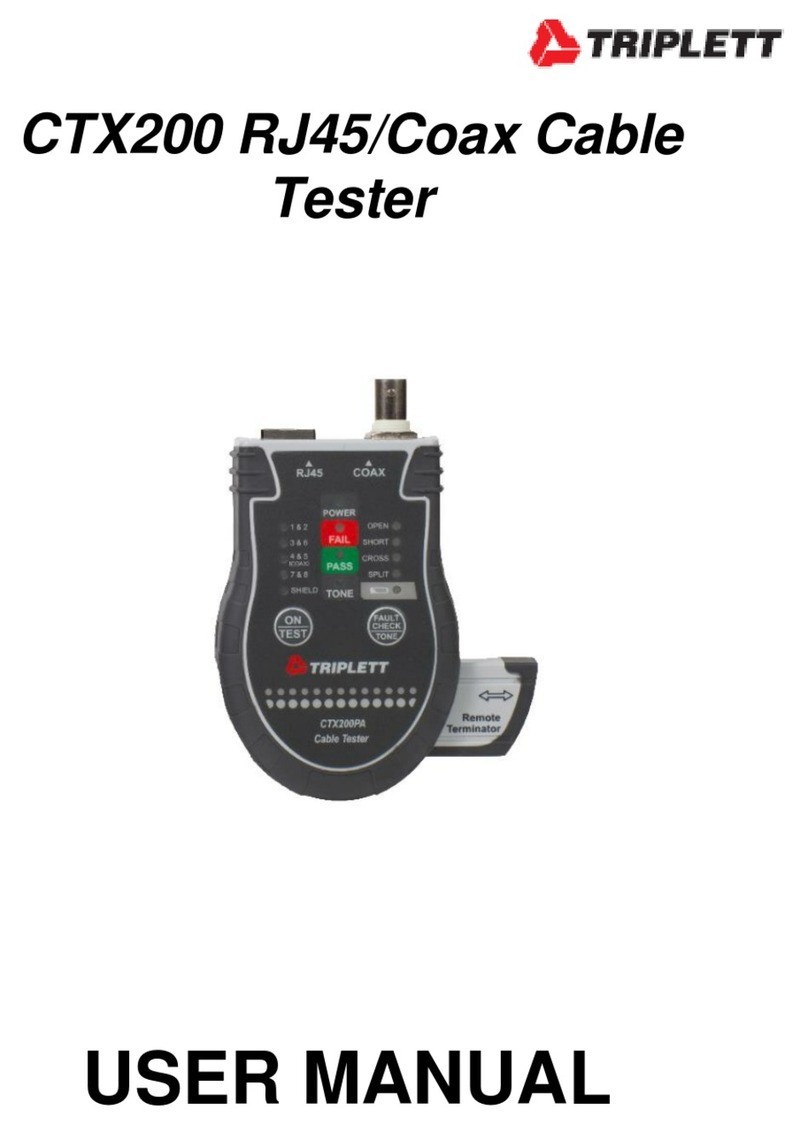
Triplett
Triplett CTX200PA user manual
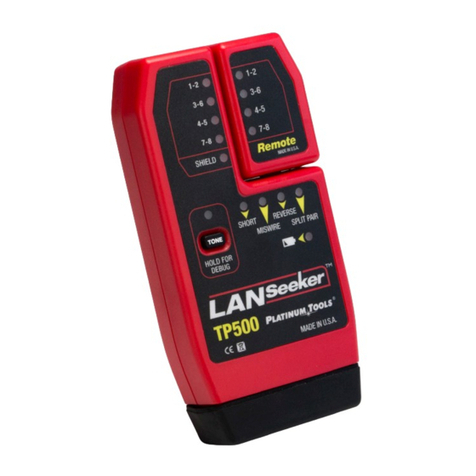
Platinum Tools
Platinum Tools LANSeeker TP500C quick start guide

SKYTRONIC
SKYTRONIC 600.616 instruction manual
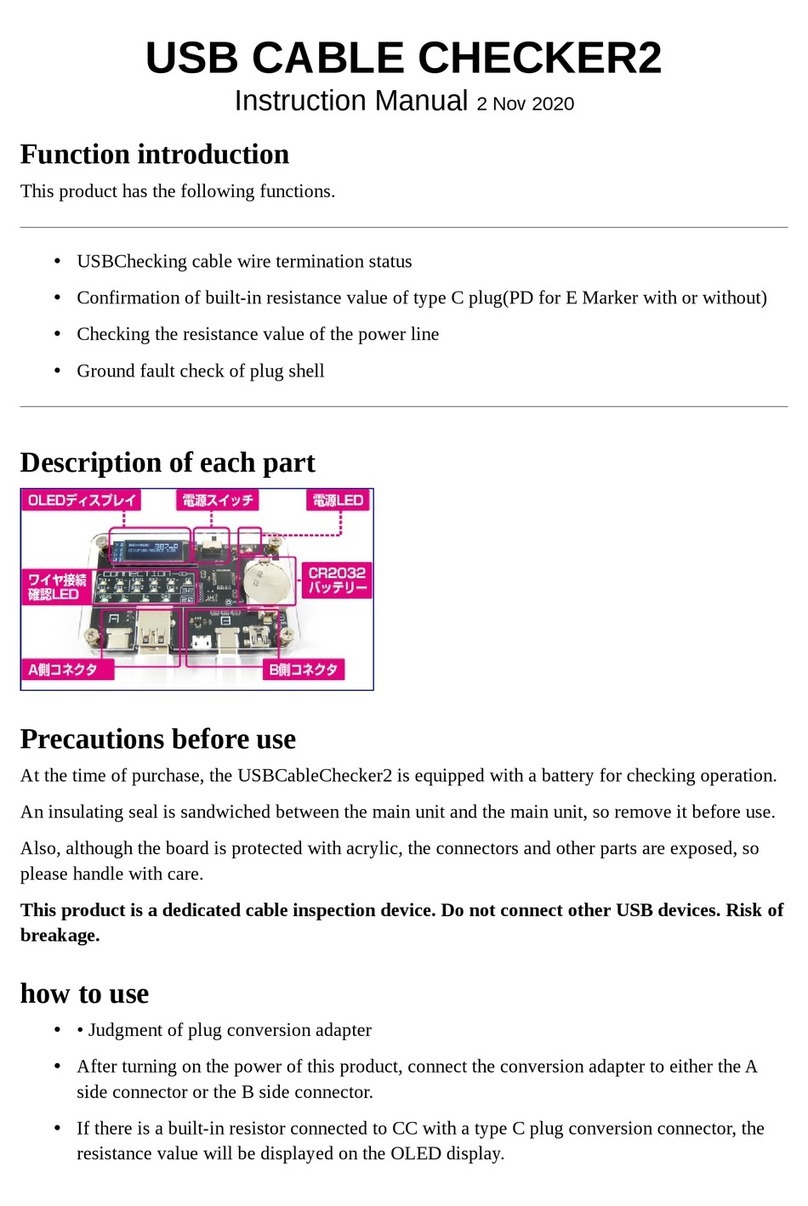
Bit Trade One
Bit Trade One USB Cable Checker2 instruction manual
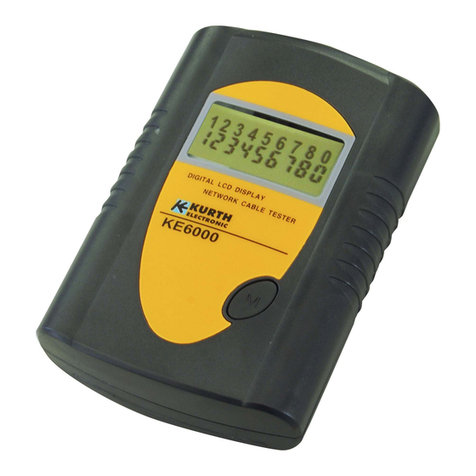
Kurth Electronic
Kurth Electronic KE6000 quick start guide

VOLTCRAFT
VOLTCRAFT VC731 operating instructions
